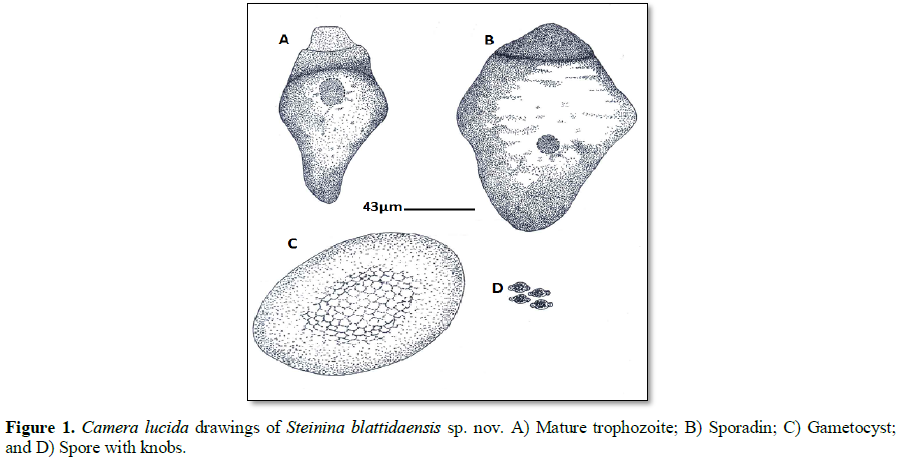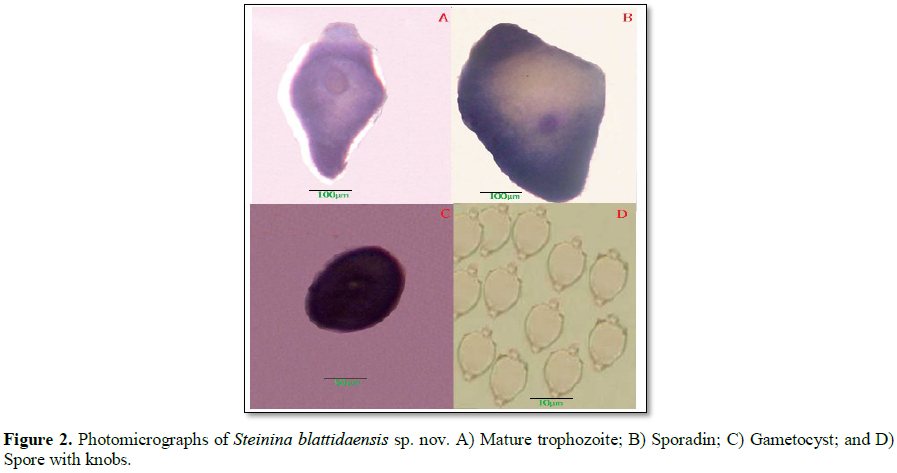728
Views & Citations10
Likes & Shares
The present paper
study with the life history and the morphology of the new cephaline gregarines
from Periplaneta americana. The
parasite has been assigned a new species Steinina
blattidaensis. sp. nov. has been described as the type of the genus Léger
and Dubscq (1904). The parasite has the following ratios: LP: TL=1:7.5; WP:
WD=1:1.4. The present percentages of infection in the mid-gut of the parasite
were 21 out of 50 (42%). A new specie Steinina
blattidaensis. sp. nov has been created according to the (Order:
Blattidae). The morphological details of the parasite of different stages
supported with photomicrographs are also provided.
Keywords: Steinina blattidaensis. sp. nov., Periplaneta
americana, Morphology, Cephaline gregarines
Abbreviations: TL: Total Length; LE: Length of Epimerite; LP:
Length of Protomerite; WP: Width of Protomerite; LD: Length of Deutomerite; WD:
Width of Deutomerite; LN: Length of Nucleus; WN: Width of Nucleus; LP:LT: Length
of Protomerite:Total Length; WP:WD: Width of Protomerite:Width of Deutomerite
INTRODUCTION
The genus Steinina was established by Léger
and Dubscq [1] to include a gregarine Steinina
ovalis (Stein). The characters of the genus Steinina by Léger and Dubscq
[1] are: Sporont Solitary, Epimerite a short retractile digitiform process in
the early stage and becoming flattened transparent button-like. Cyst spherical,
dehiscence by simple rupture and spores biconical. Later many workers like
Ashworth and Rettie [2], Ishii [3], Watson [4], Foerster [5], Hoshide [6],
Obata [7], Théodoriès and Jolivet [8], Théodoriès and Desportes [9] and
Théodoriès et al. [10] described many new species under the genus from
different parts of the world. However, the literature extent reveals that only
four cephaline gregarines under the genus Steinina have so far been reported
from India [11-13]. Later on Gupta and Haldar [14], while studying the
cephaline gregarines from the stored-grain pests of West Bengal, found
gregarines from the mid gut of the larva of the Tenebrionid bettle, Palorus
sp. and described Steinina palorousi.
In course of the present investigation, one
species of Steinina is described
which is discovered from the valley districts of Manipur. The description of
the species is made in details with illustrative diagrams and photomicrographs.
The gregarine has been described as new species
which has distinctive features of its own.
MATERIALS AND METHODS
The samples were collected from various grass
fields of Manipur with the help of net were kept in glass tubes and brought
alive to the laboratory for examination. These were decapitated; their guts
carefully dissected out under a dissecting microscope and gently pressed to
expel the parasites from the gut lumen. Thin smear preparations were fixed in
Schaudinn’s fixative and subsequently stained with Heidenhain’s haematoxylin
[15]. Gametocysts were recovered from the hind gut
and placed in moist chambers
RESULTS AND
DISCUSSION
Description
Trophozoite: Trophozoite are
found freely in the lumen in the host’s gut. Trophozoite are so far encountered
in the smear preparations. These are solitary, elongated obese in shape and are
of various sizes and measures 109.9-159 (143.1 ± 11.17) µm in total
length. The epimerite of the mature trophozoite is short retractile digitiform
process, later become flattened button-like. The epimerite measures 14.7-32.6
(23.5 ± 5.8) × 17.5-39.6 (24.2 ± 6.06 µm in
average. The protomerite is hemispherical
or dome-shaped. The protomerite is broader at its posterior extremity and
measures 14.4-40.2 (23.9 ± 6.72) × 37.4-69.4 (57.9 ± 7.4) µm in average. The
septum between the protomerite and the deutomerite is thin and there is also a
slight constriction between the protomerite and the deutomerite. The
deutomerite is elongated and is broadest near the septum. And it become
narrower towards the posterior end, terminating in a pointed to rounded
extremity. The deutomerite measures 99.6-134.4 (109.3 ± 8.01) × 55.7-89.5
(65.3 ± 7.91) µm in average. The nucleus is spherical with a single deeply stained
endosome and always situated at the anterior half of the deutomerite. It
measures 13.7-29.4 (21.7 ± 6.40) × 15.7-32.4 (22.9 ± 5.17) µm in average (Figure 2).
Sporadin: Sporadins are
solitary, with a short protomerite and a long deutomerite. The young sporadin
are very small and are of various sizes. Some are triangular in shape, the
anterior end of which is broader, gradually tapering towards the posterior end.
The sporadin measure 152.3-198.9
(186.9 ± 10.06) µmin total length. The
protomerite is dome-shaped and measures 28.9-64.3 (38.9 ± 8.16) ×
39.3-75.2 (49.3 ± 8.16) µm in average. The septum between the protomerite and the deutomerite
is convex in shape. The nucleus is
spherical and is situated at the centre of the deutomerite and measures 109.1-156.2
(119.9 ± 10.14) × 99.7-139.5 (109.6 ± 8.88) µm
in average. The deutomerite is the
largest segment of the body. It is broadest at the anterior one-third of its
length. It unevenly tapers towards the posterior extremity and end in a cone.
The cytoplasm of both protomerite and the deutomerite is highly granular. The
nucleus is subspherical or spherical in shape and measures 10.5-26.3
(18.2 ± 4.81) × 9.5-29.3 (19.3 ± 5.79) µm in
average (Figure 2).
Gametocyst: Gametocysts
collected from the hind gut of the infected hosts are oval in shaped and
measures 101.5-155.2 (137.0 ± 12.6) × 63.5-102.1 (83.1 ± 9.6) µm in dimensions.
The cyst wall is smooth and the cenreal part is more condensed than its
periphery. After 48 hrs of development inside the moist chamber the spores are
formed within the cyst (Figure 2).
Spore: Spores are
biconical. The button-like hyaline, subconical knobs form the two poles of the
spores. The spore measure 13.5 × 10.5 µm in dimensions. After 40 h, the
sporozoites are clearly discernable. These are eight in number and are arranged
in a circular fashion inside the spore (Figure 2).
Taxonomic
summary
Type
material: Steinina blattidaensis.
sp. nov.
Type
host: Periplaneta americana (Order:
Blattidae)
Type
locality: Canchipur, Imphal (west)
Site
of infection: Mid gut
Prevalance: 21 out of 50
(42%)
Paratype: MU/0213/14, deposited in the
Protozoan Collection of Parasitology Section, Centre of Advanced Studies in
Life Sciences, Manipur University, Canchipur-795003, India
Holotype: MU/022/14, deposited in the
Protozoan Collection of Parasitology Section, Centre of Advanced Studies in
Life Sciences, Manipur University, Canchipur-795003, India
Measurements: Summary of measurements in micrometers of preserved (fixed and stained) Trophozoites and Sporadins are provided (Table 1).
Paratype (20): Slide No. MU/0213/14
Trophozoite
TL=109.9-159 (143.1 ± 11.17)
LE=14.7-32.6 (23.5 ± 5.8)
WE=17.5- 39.6 (24.2 ± 6.06)
LP=14.4-40.2 (23.9 ± 6.72)
WP=37.4-69.4 (57.9 ± 7.4)
LD=99.6-134.4 (109.3 ± 8.01)
WD=55.7-89.5 (65.3 ± 7.91)
LN=13.7-29.4 (21.7 ± 6.40)
WN=15.7-32.4 (22.9 ± 5.17)
LP:LT=1:7.5
WP:WD=1:1.4
Sporadin
TL=152.3-198.9 (186.9 ±
10.06)
LP=28.9-64.3 (38.9 ± 8.16)
WP=39.3-75.2 (49.3 ± 8.16)
LD=109.1-156.2 (119.9 ±
10.14)
WD=99.7-139.5 (109.6 ± 8.88)
LN=10.5-26.3 (18.2 ± 4.81)
WN=9.5-29.3 (19.3 ± 5.79)
LP:LT=1:5.3
WP:WD=1:2.5
Holotype: Slide No.
MU/022/14
Trophozoite
LT=148
LE=21.5
WE=26.87
LP=19.5
WP=48.75
LD=105
WD=69.87
LN=21.5
WN=23.2
LP:LT=1:7.5
WP:WD=1:1.4
Sporadin
LT=172
LP=32.2
WP=48.37
LD=139.7
WD=125.7
LN=17.7
WN=12.5
LP:LT=1:5.3
WP:WD=1:2.5
DISCUSSION AND CONCLUSION
The present gregarine possesses solitary
sporadins, bears short retractile digitiform process in its epimerite,
gametocyst and dehisces by simple rupture releasing biconical spores, thereby
justifying its inclusion under the genus Steinina Léger and Duboscq [1] (Table 2).
The present species quite resembles S. ovalis Léger and Dubsoscq [1] in the ratio of WP:WD, cyst and spore. But it differ from the species in the feature of the trophozoite, the protomerite, deutomerite of the sporadin and in the measurement of different parts of the body (Trophozoite 109-159 µm in size are solitary, dome shaped protomerite of sporadin 28.9-64.3 × 39.3-75.2 µm, deutomerite of sporadin is convex in sharp 109.1-156.2 × 99.7-139.5 µm in average in the present species). It also come close to the measurement range given for S. minor Obata, 1953 specially in the ratio of LP:TL but there is no agreement in other features like the shape of the triphozoite, epimerite, nucleus and cyst (Trophozoite elongated 109.9-159 µm in total length, Epimerite of the mature trophozoite is a short retractile digitiform process, 14.7-32.6 × 17.5-39.6 µm , Nucleus is spherical 13.7-29.4 × 15.7-32.4 µm and cyst is oval, 101.5-155.2 × 63.5-102.1 µm in dimensions in the present species). The gregarine, therefore is given a separate specific status for which the name Steinina blattidaensis .sp. nov. is proposed.
ACKNOWLEDGEMENT
The authors are grateful to the Head,
Department of Life Sciences and Co-ordinator, Centre of Advanced Studies in
Life Sciences, Manipur University provided the laboratory facilities and the
first author acknowledge the financial assistance provided by Manipur
University for Ph.D work.
1.
Lèger L, Duboscq O (1904)
Nouvelles recherches sur les grégarines et l'épithélium intestinal des
trachéates. Arch Protistenk 4: 335-383.
2.
Ashworth JH, Rettie T (1912) On
a gregarine Steinina rotundata nov.
sp. present in the mid-gut of bird-fleas of the genus Ceratophylus. Proc R Soc
Lond Ser B Biol Sci 86: 31-38.
3.
Ishii S (1914) On four
polycystid gregarines from the intestine of Tribolium
ferrugineum rubiginous Koch. Zool Mag 61: 278-280.
4.
Watson ME (1916) Studies on
gregarines. Illi Biol Monogr 2: 1-258.
5.
Foerster H (1938) Gregarinen in
Schlesischen Insekten. Z Parasilerid 10: 157-210.
6.
Hoshide H (1952) Studies on
five new gregarines from dioplopods in Ysmaguchi prefecture of Japan. Ibid 3:
14.
7.
Obata K (1953) Reports on some
gregarines from Japanese insects. J Sci Hiroshima Univ (Zool) 14: 1-34.
8.
Théodoridés J, Jolivet P (1959)
Eugrégarinés parasites de Coléoptéres explore. Parc Nat Albert e Série, pp:
8-45.
9.
Théodoridès J, Desportes I
(1966) Quelques Grégarines de coléoptères du Laos. Protistol 2: 53-58.
10.
Théodoridès J, Desportes I,
Jolivet P (1972) Grégarines de la nouvellequienee et de iles voisines. Cah
Pacif 16: 110-168.
11.
Uttangi JC, Desai RN (1962) On
some gregarines from the non-sylophagus termites Speculitermes cyclopssinhalensis from Dharwar (India). J Anim Morph
Physiol 9: 97-109.
12.
Sarkar NK, Chakravarty M (1969)
Gregarines (Protozoa: Sporozoa) from insects. I. New cephaline gregarines of
the family Actinocephalidae. Proc Zool Soc (Calcutta) 22: 17-29.
13.
Kalavati C, Narasimhamurti CC
(1978) Three new species of gregarines from termites. Proc Indian Acad Sci 87:
397-340.
14.
Gupta SK, Holder DP (1987) Steinina palorusi n. sp., a new species
of septate gregarines (Apicomplexa: Sporozoea) from the larva of a tenebrionid
beetle. Arch Protistenk 133: 135-144.
15.
Kudo (1966) Studies on Nyctanthes arbortristis Linn. Proc
Indian Sci.
16.
Sprague V (1941) Studies on Gregarina blattarum with particular
reference in the chromosome cycle. Univ. III. Biol Monogr 18: 5-57.
17.
Clopton RE (2004) Standard
nomenclature and metrics of plane shapes for use in gregarine taxonomy. Comp
Parasitol 71: 140.
QUICK LINKS
- SUBMIT MANUSCRIPT
- RECOMMEND THE JOURNAL
-
SUBSCRIBE FOR ALERTS
RELATED JOURNALS
- International Journal of Internal Medicine and Geriatrics (ISSN: 2689-7687)
- Journal of Blood Transfusions and Diseases (ISSN:2641-4023)
- Journal of Rheumatology Research (ISSN:2641-6999)
- Journal of Ageing and Restorative Medicine (ISSN:2637-7403)
- Archive of Obstetrics Gynecology and Reproductive Medicine (ISSN:2640-2297)
- International Journal of Diabetes (ISSN: 2644-3031)
- International Journal of Radiography Imaging & Radiation Therapy (ISSN:2642-0392)



